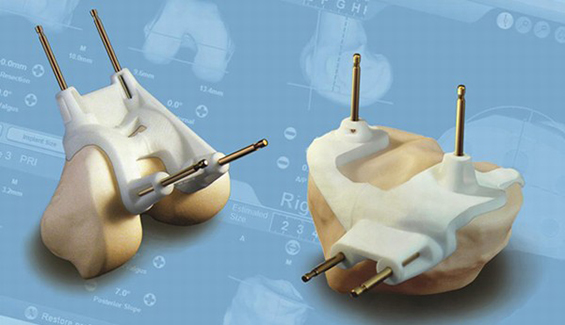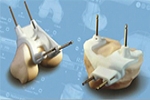
There are several competing techniques available for knee replacement surgery. For the last eight years some Orthopaedic surgeons and implant companies have been heavily marketing so called ‘patient specific’ knee replacement surgery as providing improved accuracy and outcomes. I have been telling my patients that the evidence is simply not there to justify these claims whereas there is good evidence that computer navigation does reduce revision rates in knee replacements. The verdict is now in and the highly respected Australian Orthopaedic Association National Joint Replacement Registry (AOANJRR) has just reported that this ‘patient specific’ technique actually performs worse than other techniques.
So what does ‘patient specific’ mean?
Also called ‘imaged derived instrumentation’, the technique requires a pre-operative CT or MRI scan which is then digitally sent to implant manufacturer, usually overseas. A technician uses the scan and a 3D printer to create customized cutting jigs which are then sent back to Australia. I always had a few concerns regarding this process. The first is in relation to potentially risky radiation exposure from the CT scan which is otherwise not needed, and I have written about this previously in relation to robot arm technology. I was also concerned about the idea of delegating responsibility for an important part for the surgery to a technician in a different country. The process of creating the instruments also takes weeks and this is an unnecessary delay. Lastly I was concerned that the instruments may not always fit properly, potentially leading to poorly aligned implants. Given the results now available it appears my concerns were justified.
The AOANJRR report reviewed 20,391 knee replacements performed using ‘patient specific’ technique and 96,730 knee replacements performed using computer navigation. These were compared to all other knee replacements. In patients 65 years of age and over there was an increased rate of revision using the ‘patient specific’ technique compared to other techniques including computer navigation. In patients aged under 65 years there was no difference between the ‘patient specific’ and standard technique, but there was a lower rate of revision when using computer navigation. These differences were statistically significant. For those interested in the data the report is available below.
What this means is that when comparing revision surgery rates, ‘patient specific’ knee replacements actually provide no benefit to the patient, and computer navigation is a better technique for all ages.
So who does benefit from the ‘patient specific’ technique?
The implant manufacturer benefits because the size of the implant has been predetermined and they don’t need to supply as many instruments and implants to the hospital. The hospital benefits because there isn’t as much equipment to process and sterilize. The surgeon benefits because the surgery is quicker and there is a perceived marketing advantage in using new technology. The only one who doesn’t benefit is the most important person in the operating room – the patient.
For more information on knee replacement surgery click here.
If you would like to make an appointment with Dr Bauze click here for consulting locations and contact details.
Reference
- Australian Orthopaedic Association National Joint Replacement Registry. Annual Report. Adelaide: AOA; 2017. p216-219







